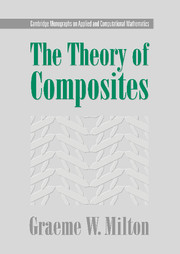Book contents
- Frontmatter
- Contents
- List of figures
- Preface
- 1 Introduction
- 2 Some equations of interest and numerical approaches to solving them
- 3 Duality transformations in two-dimensional media
- 4 Translations and equivalent media
- 5 Some microstructure-independent exact relations
- 6 Exact relations for coupled equations
- 7 Assemblages of spheres, ellipsoids, and other neutral inclusions
- 8 Tricks for generating other exactly solvable microgeometries
- 9 Laminate materials
- 10 Approximations and asymptotic formulas
- 11 Wave propagation in the quasistatic limit
- 12 Reformulating the problem of finding effective tensors
- 13 Variational principles and inequalities
- 14 Series expansions for the fields and effective tensors
- 15 Correlation functions and how they enter series expansions†
- 16 Other perturbation solutions
- 17 The general theory of exact relations and links between effective tensors
- 18 Analytic properties
- 19 Y-tensors
- 20 Y-tensors and effective tensors in electrical circuits†
- 21 Bounds on the properties of composites
- 22 Classical variational principle bounds
- 23 Bounds from the Hashin-Shtrikman variational inequalities
- 24 Bounds using the compensated compactness or translation method
- 25 Choosing the translations and finding microgeometries that attain the bounds†
- 26 Bounds incorporating three-point correlation functions†
- 27 Bounds using the analytic method
- 28 Fractional linear transformations as a tool for generating bounds†
- 29 The field equation recursion method†
- 30 Properties of the G-closure and extremal families of composites
- 31 The bounding of effective moduli as a quasiconvexification problem
- Author index
- Subject index
21 - Bounds on the properties of composites
- Frontmatter
- Contents
- List of figures
- Preface
- 1 Introduction
- 2 Some equations of interest and numerical approaches to solving them
- 3 Duality transformations in two-dimensional media
- 4 Translations and equivalent media
- 5 Some microstructure-independent exact relations
- 6 Exact relations for coupled equations
- 7 Assemblages of spheres, ellipsoids, and other neutral inclusions
- 8 Tricks for generating other exactly solvable microgeometries
- 9 Laminate materials
- 10 Approximations and asymptotic formulas
- 11 Wave propagation in the quasistatic limit
- 12 Reformulating the problem of finding effective tensors
- 13 Variational principles and inequalities
- 14 Series expansions for the fields and effective tensors
- 15 Correlation functions and how they enter series expansions†
- 16 Other perturbation solutions
- 17 The general theory of exact relations and links between effective tensors
- 18 Analytic properties
- 19 Y-tensors
- 20 Y-tensors and effective tensors in electrical circuits†
- 21 Bounds on the properties of composites
- 22 Classical variational principle bounds
- 23 Bounds from the Hashin-Shtrikman variational inequalities
- 24 Bounds using the compensated compactness or translation method
- 25 Choosing the translations and finding microgeometries that attain the bounds†
- 26 Bounds incorporating three-point correlation functions†
- 27 Bounds using the analytic method
- 28 Fractional linear transformations as a tool for generating bounds†
- 29 The field equation recursion method†
- 30 Properties of the G-closure and extremal families of composites
- 31 The bounding of effective moduli as a quasiconvexification problem
- Author index
- Subject index
Summary
Why are bounds useful?
Very efficient numerical algorithms are currently available for calculating the effective tensors of quite complicated two-dimensional microgeometries. The numerical evaluation of effective tensors for three-dimensional microgeometries is also progressing rapidly. In light of these advances one might ask: Why is there a need for developing bounds on effective tensors? One reason is that they often provide quick and simple estimates for the effective tensors.
Another reason for favoring bounds is that in most experimental situations we do not have a complete knowledge of the composite geometry. Even when an accurate determination of the three-dimensional composite microgeometry is possible, obtaining this information and numerically parameterizing it (which may involve the triangulation of boundaries between phases) can be a very time-consuming process. Cross-sectional photographs give only limited information. For example, in a two-phase microgeometry it can be difficult to judge whether a phase is connected if a cross-sectional photograph shows only islands of that phase surrounded by the second phase. In the three-dimensional microgeometry, does the first phase consist of connected wire-like filaments, or does it consist of isolated elongated inclusions? The answer could have a large influence on one's estimates for, say, the effective conductivity when both phases have widely different conductivities. The problem of reconstructing the three-dimensional microstructure from a cross-sectional photograph is the subject of active research; see Yeong and Torquato (1998) and references therein.
Information
- Type
- Chapter
- Information
- The Theory of Composites , pp. 425 - 436Publisher: Cambridge University PressPrint publication year: 2002
